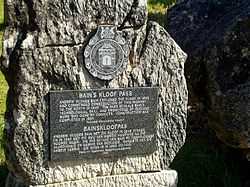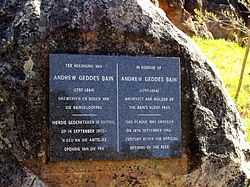Bain's Kloof Pass



Coordinates: 33°36′08.6″S 19°06′42.2″E / 33.602389°S 19.111722°E Bainskloof Pass is situated in the Western Cape province of South Africa, on the Regional road R301 between Wellington and Ceres. This 30 kilometer pass was completed in 1853 and is one of the most picturesque passes in the Cape. The pass was built using convict labour, by Andrew Geddes Bain, the most famous of southern Africa's road engineers. Bain achieved this remarkable feat without any formal training. At the summit (595 metres (1,952 ft)) are a plantation and picnic ground. Here the road joins the Witte River, which descends the northern side of the mountains through a precipitous cleft to a stretch of rapids, waterfalls and natural pools. Bainskloof was originally built for horse drawn traffic in 1853. Since then the western side has been somewhat altered but the eastern side is pretty much as it was other than it has been tarred.
Halfway down the pass is a camping ground, with a river pool set amid smooth boulders. A circular walk through what is known as Wolvenkloof begins here, featuring many rock formations and wild flowers.
Bain's Kloof Pass is a National Monument which blends in perfectly with its natural surroundings.
SOME QUICK BAINSKLOOF FACTS:
- Bainskloof, situated in the Cape's floral kingdom, is unique in that it contains the highest ratio of plant species per land area in the world - a total of 8600 species of which 5800 is endemic
- The flora of Bainskloof encompasses an astounding 277 varieties of flowering plants. These include 24 types of Erica, 10 types of Gladioli and 13 types of Protea
- Bainskloof's fauna includes a selection of a 182 bird species in addition to otters, jackals, leopards, honey badgers, klipspringers, grysbok, steenbok, endangered frogs and some unique fish swimming in the streams
- Scotsman Andrew Geddes Bain built Bainskloof Pass. It was the first inland passage to the north and South Africa's interior
- Completed in 1853, the pass became one of the most scenic routes in the Cape
- The pass traverses the Limietberg mountains, establishing a route between the town of Wellington and the interior
- The pass were completed in 4 years (1608 working days)
- An average of 53 days were devoted to a kilometer of construction
- Bainskloof is part of the Limietberg Nature Reserve and was declared a National Monument in 1980
- The pass lies within a natural heritage area that forms part of the Cape Floral Region, one of 8 world heritage sites in South Africa as established by Unesco's World Heritage Committee at the 29th session in Suzhou, China in July 2004
- The pass gradient from Wellington rises from 300m to 595m above sea level
- A dry-masonry method of construction was used to build the pass
- The pass lies within an area that is rich in fynbos with multiple Protea species
- Bainskloof attracts many ecotourists, particularly in the spring and summer months
- Adventurers flock to Bainskloof to participate in mountain biking, hiking and swimming in the fresh water pools
- The unspoilt nature of Bainskloof makes it an ideal area for environmental field workshops from universities or exploration by researchers
- Bain's Cape Mountain Whisky, a single grain whisky distilled at The James Sedgwick Distillery in Wellington was named after Andrew Geddes Bain
- The Bainskloof Ultra Marathon is an annual event which entails running the Pass as part of the route
External links
- Passes Index at Wild Dog Adventure Riding website
http://bainskloof.org.za/history/index.html